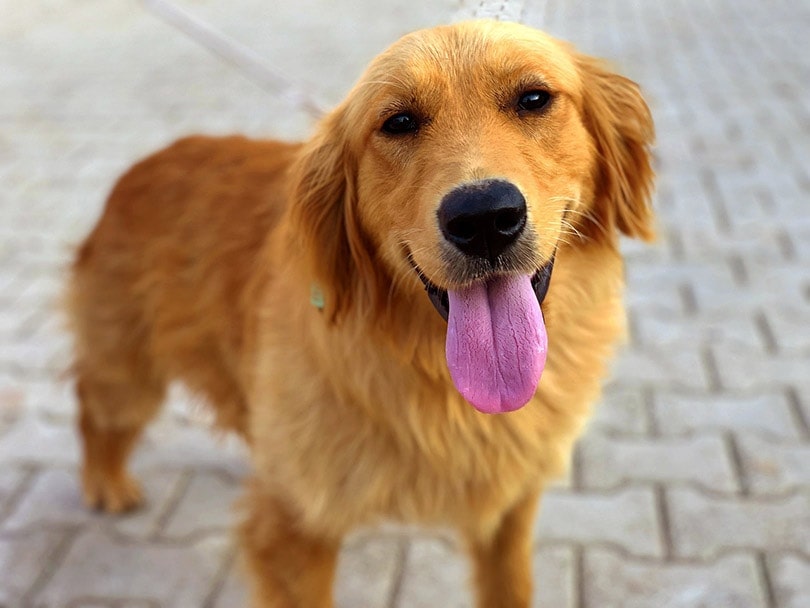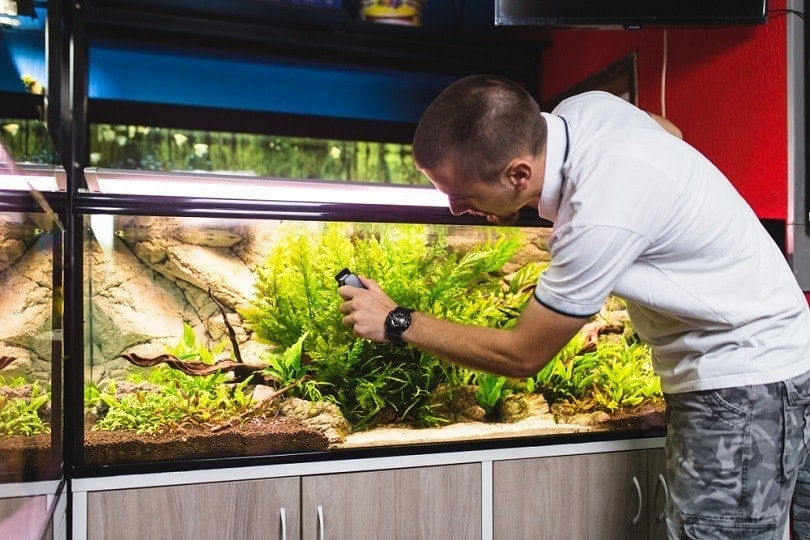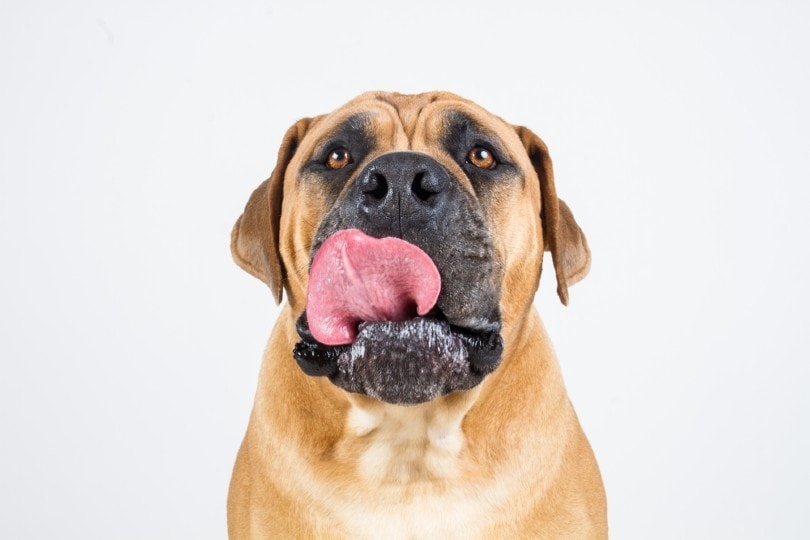Australian Shepherd Growth & Weight Chart (Puppy to Adult)

Updated on
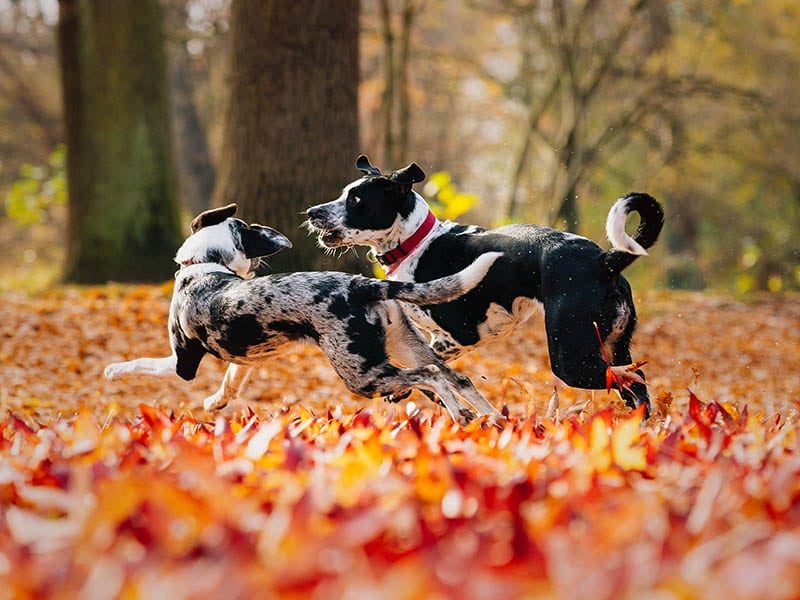
Click to Skip Ahead
Australian Shepherds are one of America’s puppy sweethearts and among some of the more popular dogs. They particularly suit people who need a high-energy dog to keep up with an active lifestyle. They are hard workers and are often used as assistance dogs in a variety of capacities.
Adopting an Australian Shepherd is akin to bringing a fluffy bundle of joy and energy to your home. They are commonly called an Aussie, and the shorter name better suits this calico-colored puppy. They often have blue eyes that might change as they grow older. The colors on their coat can also vary and shift as they age.
What kind of things should you expect from them as they grow? If you want to keep track of your puppy’s growth and understand the typical rates to keep up with their health, then check our Australian Shepherd growth charts to learn what to expect each month toward adulthood.
Australian Shepherd Puppy Growth and Weight Chart
The charts below demonstrate how your pup will grow each passing week and month. It includes the average Australian Shepherd weight and height in typical ranges. Not every puppy is the same. If you have been following up with the appropriate veterinarian visits, they can tell you if your pup is still in a healthy range.
Australian Shepherd Puppy Growth and Weight Chart (Male)
| Weight Range | Height Range | |
| 8 weeks | 5-7 lbs. | 3”-5” |
| 9 weeks | 7-12 lbs. | 5”-8” |
| 10 weeks | 15-19 lbs. | 7”-11” |
| 11 weeks | 18-23 lbs. | 9”-12” |
| 3 months | 21-27 lbs. | 11”-13” |
| 4 months | 28-35 lbs. | 12”-14” |
| 5 months | 34-43 lbs. | 13”-15” |
| 6 months | 38-49 lbs. | 15”-17” |
| 7 months | 44-55 lbs. | 16”-18” |
| 8 months | 47-58 lbs. | 17”-19” |
| 9 months | 49-63 lbs. | 18”-20” |
| 10 months | 51-65 lbs. | 19”-21” |
| 11 months | 53-67 lbs. | 20”-22” |
| 1 year | 54-68 lbs. | 20”-23” |
| 2 years | 56-69 lbs. | 20”-23” |

Australian Shepherd Puppy Growth and Weight Chart (Female)
| Weight Range | Height Range | |
| 8 weeks | 4-8 lbs. | 3”-5” |
| 9 weeks | 6-11 lbs. | 5”-8” |
| 10 weeks | 10-15 lbs. | 7”-11” |
| 11 weeks | 12-19 lbs. | 9”-12” |
| 3 months | 14-21 lbs. | 11”-13” |
| 4 months | 19-28 lbs. | 11”-14” |
| 5 months | 23-35 lbs. | 12”-14” |
| 6 months | 26-39 lbs. | 13”-15” |
| 7 months | 29-44 lbs. | 14”-16” |
| 8 months | 31-47 lbs. | 15”-17” |
| 9 months | 33-49 lbs. | 16”-18” |
| 10 months | 34-51 lbs. | 17”-18” |
| 11 months | 35-52 lbs. | 18”-20” |
| 1 year | 36-54 lbs. | 18”-21” |
| 2 years | 37-55 lbs. | 18”-21” |
You need to take good care of your pet while they are growing, so you can use our calculator tool to help you know how much to feed your pup and keep their well-being:
The exact amount of calories an individual animal needs to maintain a healthy weight is variable and influenced by many factors including genetics, age, breed, and activity level. This tool is meant to be used only as a guideline for healthy individuals and does not substitute veterinary advice
Australian Shepherd Growth Stages (with Pictures)
It is good to know what to expect each step of the way to monitor your pup’s growth and development successfully. From the time they are born to when they hit adulthood, there are many changes for your little puppy. It happens much faster than in humans and should be monitored carefully.
8-Week-Old (2 Months) Australian Shepherd
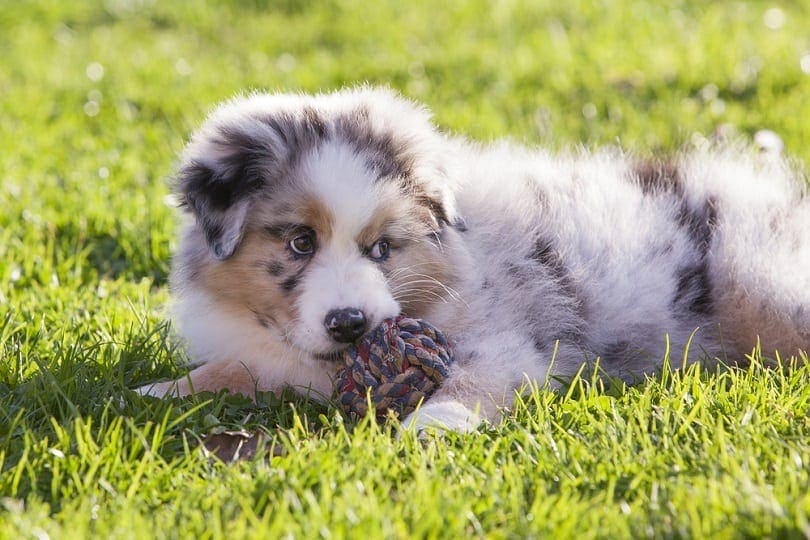
From birth to the time that they develop into an 8-week-old Australian Shepherd, they will probably be with their breeder. As you can see from the charts above, they grow quite quickly. When they come to you at this age, depending on whether they are male or female, an 8-week-old Australian Shepherd is usually between 4 and 8 pounds.
At this point, they are typically deemed old enough to leave their mother. It is also the time that they are mentally developed enough to begin housetraining. They should be introduced to solid food, and the rest of this adjustment will fall into your hands.
At about 2 months of age, it is essential to start socializing your puppy. Everything is going to be new to them, and the world is a large place for such a small dog. Get them accustomed to different people and other animals, especially if you intend for them to live in a house with more dogs, cats, or other pets.
12-Week-Old (3 Months) Australian Shepherd
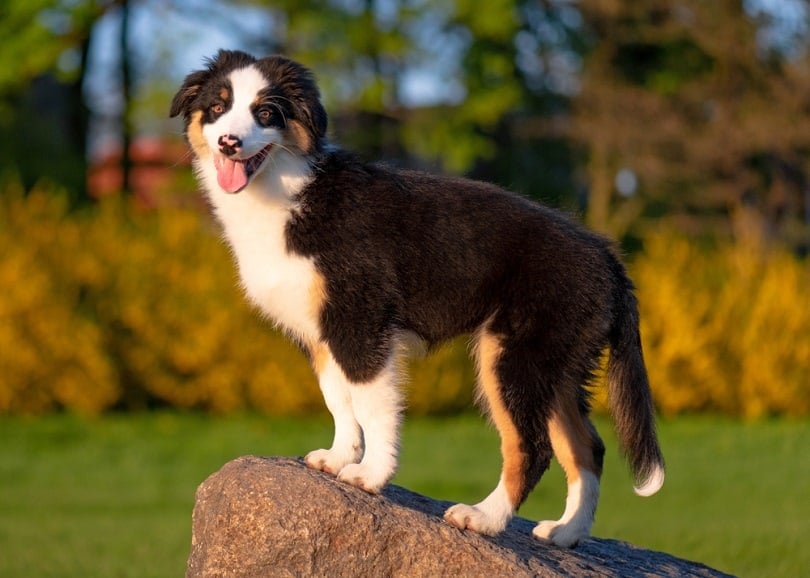
When your puppy is 7 to 9 weeks old, their senses are fully developed, and they have grown accustomed to their sense of smell, sight, and sound. This is typically when a puppy also begins to react with fear to everyday household objects. They need this adjustment period and should be guided through it.
It is at this point that a puppy will be going through an intense chewing phase. Although it might be extremely irritating, especially when they latch onto a stranger, it is normal behavior. They need affirmative training to teach them when it is and isn’t appropriate to act like this.
From 3 months forward, they begin teething, which is part of the motivation to chew on things. It often brings them relief, so give them toys that they can chew on responsibly.
6-Month-Old Australian Shepherd
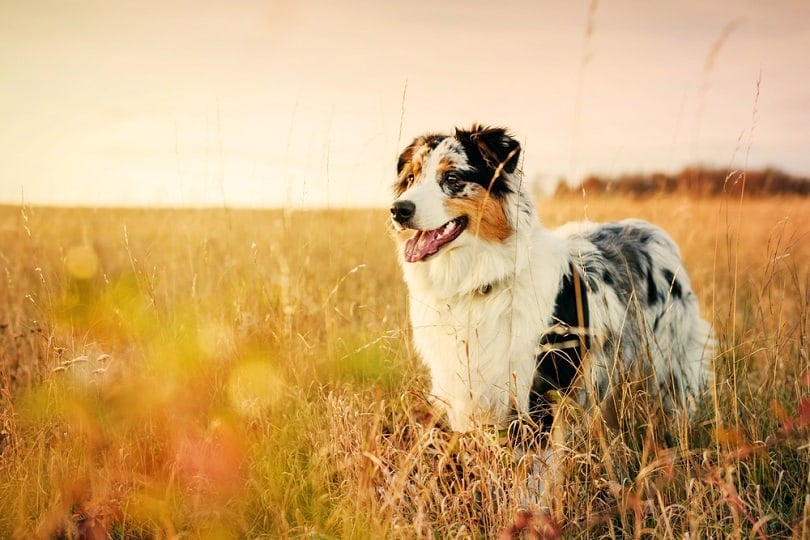
A 6-month-old Australian Shepherd puppy is normally done teething and can move forward in their chewing stage. They are also trying to figure out their standing within their family “pack.” That not only means comparing themselves to other animals in the house but also their human counterparts.
It is typical for a pup to enter into another chewing phase at about 7 months of age. It can be a reaction to physical and hormonal changes in their body. If they are excited, they tend to react physically.
At about 6 months old, they begin to fill out and start looking less like a puppy. They grow remarkably fast in terms of strength at this point as well.
12-Month-Old (1 year) Australian Shepherd
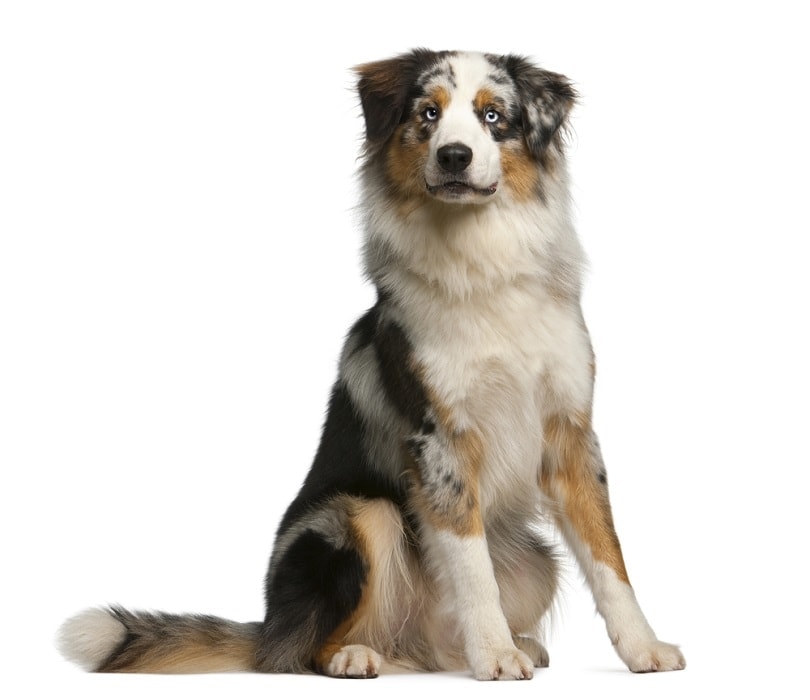
Between the 9th and 12th month, a puppy can be transitioned to adult food without it impacting their health negatively. Their adult coat should have grown in completely, and their eye color will have balanced out.
A pup that has hit 1 year can be completely transitioned to a typical exercise regimen for an adult of their breed. For an Australian Shepherd, that normally means they need at least an hour of activity each day, with at least 20 minutes of that being more intense activity.
If your puppy hasn’t been spayed or neutered at this point, then it is after 6 months that they begin to experience their first sexual behaviors.
When Do Australian Shepherds Stop Growing?
Normally, Australian Shepherds stop growing at about 16 months old. They often reach their full height at around 1 year but will continue to fill out until that 16-month mark. They do slow down about 8 months old in terms of growth, so if you have a pup that has been rocketing up in size and is about 6 months old, don’t worry too much.
Male dogs do tend to outweigh their female counterparts in this breed, but it depends on their parent’s genetics. Males can be anywhere from 10 pounds and up and typically stand about an inch taller than females.
Their brains mature while they sexually mature as well. They will continue to behave like a puppy until they are at least a year old. This age is when you may begin to notice them mellowing out, and by the time that they are 2 years old, they will behave as an adult.
How Does Neutering/Spaying Affect My Dog’s Growth?
Scientists have gone back and forth on whether spaying or neutering your dog will affect their growth. The current research supports the theory that spaying or neutering them earlier will increase the amount of time that their bones have to grow. That means they might end up being taller.
Often, dogs are spayed or neutered as early as it is healthy, typically any time after about 8 weeks of age. However, you should verify this with your vet, according to how your dog has grown.
The concern with spaying or neutering a dog too early is that their joints will not align properly, although this has yet to be completely proven.
Dangers of Growing Too Quickly or Stunted Growth
Growing too quickly presents a danger to your dog. It doesn’t occur frequently, but they can grow too fast, and it creates significant health issues later on down the line. These include problems with the development of bones, joints growing in out of line, weakness in their tendons and muscles, and sensitive spots focused on their nerves.
Growing too fast might result from feeding them the wrong diet, such as feeding a mini Aussie a diet for a medium or large-breed puppy. There are different concentrations of certain compounds to support the right amount of growth in size-specific formulas.
Too much exercise that is inappropriate for their age is another way that this could occur. Their body will try to compensate for the additional stresses on the system by growing faster.
The 5 Facts about the Australian Shepherd
1. The Australian Shepherd is not Australian.
The name of the Australian Shepherd is quite misleading because they are not from Australia. They were initially from the Basque region of Spain and were developed as a cowboy dog in America early in the country’s history.
2. Native Americans treated Australian Shepherds as sacred animals.
Native Americans regarded the Australian Shepherds as sacred because of their bright blue eyes. They called them “ghost eyes.”
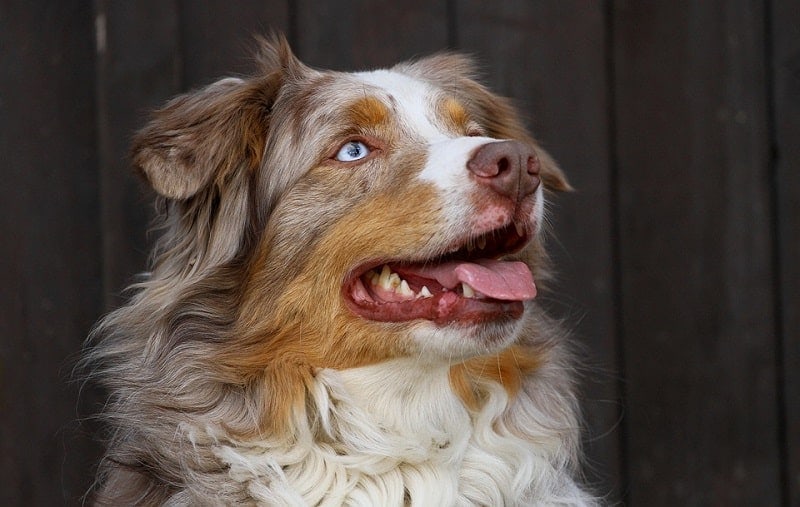
3. Heterochromia is typical for this breed.
Heterochromia is what it is called when animals or humans have two different colored eyes. In the case of an Australian Shepherd, one is often blue and the other is brown.
4. They naturally have bobbed tails most of the time.
Although it might look like they have cropped tails, they are typically born stubby and short.
5. Australian Shepherds have always been hard-working dogs.
Throughout their history, Australian Shepherds have been used as working dogs and have fulfilled various jobs. These include being herding dogs, hearing dogs, drug dogs, seeing-eye dogs, and even rescue dogs.
Conclusion
As you keep an eye on your adorable puppy, look for these indicators of healthy growth. Although weight is an easily measurable metric, it isn’t always the best indicator of the health of your pup. Maintain recommended visits to your veterinarian to assure yourself of your dog’s continued health.
- Related Reads: Are Australian Shepherds Hypoallergenic?
Featured Image Credit: PhoTonie, Shutterstock




